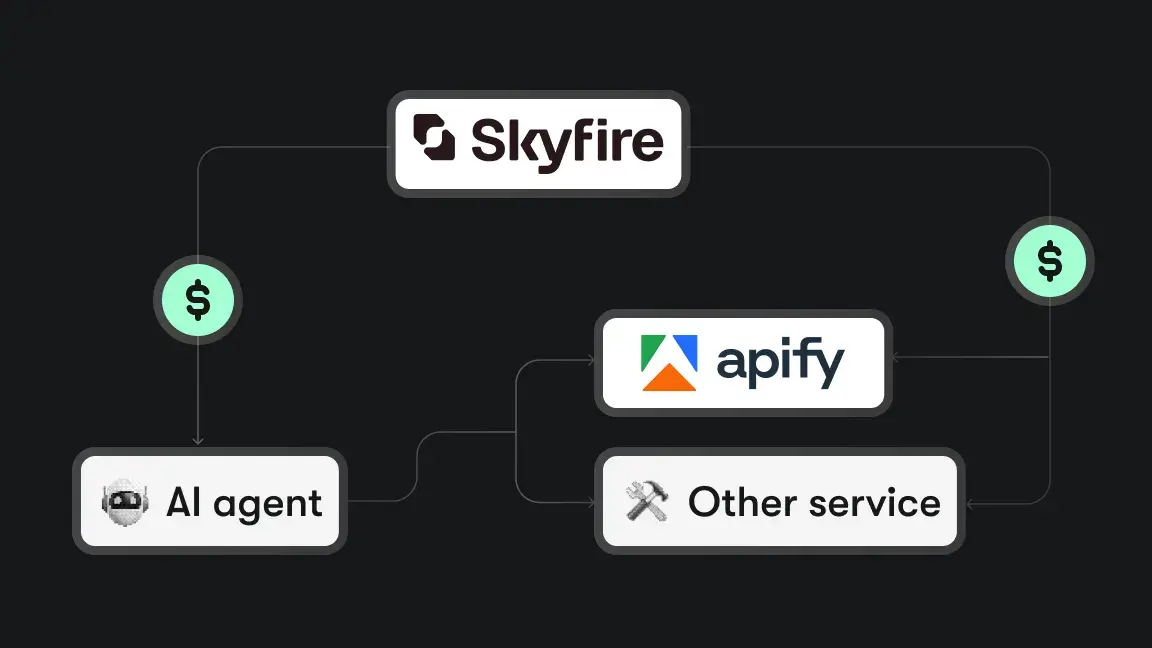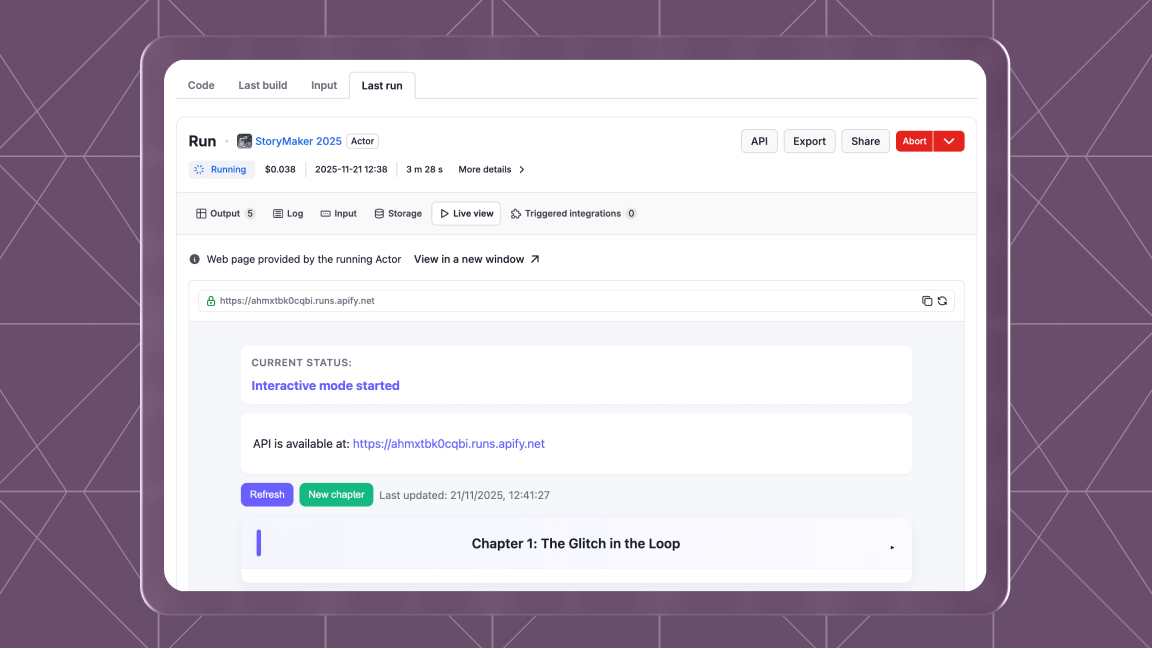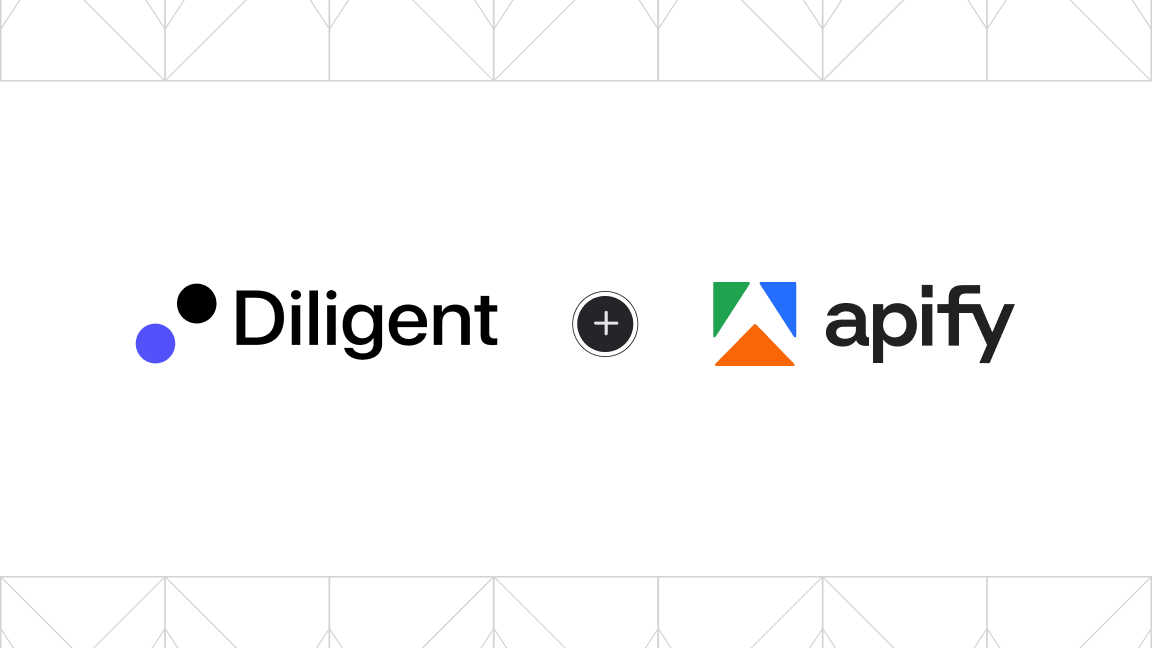Scrapers today face four fundamental hurdles:
- Dynamically-loaded content
- Frequent layout changes
- Tougher bot defenses
- Scaling
AI web scraping promises to ease these problems, but it’s no silver bullet. Below, each challenge or failure of traditional scrapers is matched to an AI or machine learning technique that can help, and the caveats you need to know.
What is AI web scraping?
- Key takeaway: Instead of relying solely on hard-coded CSS or XPath selectors to pick out elements, AI scrapers apply models trained to actually understand the page.
AI web scraping combines traditional scraping methods with machine learning techniques, mainly natural language processing (NLP) and computer vision, to make data extraction smarter and more adaptable.
Headless browsers, which are already widely used to render dynamic websites, still play their usual role: loading the full page so that all the content, including dynamically generated parts, becomes accessible. The “AI” part, however, doesn’t happen during rendering; it kicks in afterward, when the page is analyzed.
Instead of relying solely on hard-coded CSS or XPath selectors to pick out elements, AI scrapers apply models trained to actually understand the page. Computer vision models look at the page almost like a human would, recognizing where tables, product listings, or review cards are based on the page’s visual structure and layout. Meanwhile, NLP models analyze the text content, figuring out which pieces are product names, prices, descriptions, or user reviews based on semantic meaning.
This combination of visual understanding and semantic analysis makes AI web scraping much more resilient and flexible. It speeds up scraper development and cuts down on the constant maintenance needed to keep scrapers running, especially on websites that deliberately try to block automated bots.
Web scraping problems and how AI can (or can’t) solve them
1. Dynamic content vs. visual and semantic scraping
- Key takeaway: AI isn't needed to render JavaScript, but it's good at finding elements even when the HTML keeps changing.
Traditional scrapers send an HTTP GET request, parse the static HTML, and extract data using tags or CSS selectors. This works fine for simple, server-rendered pages. To handle dynamically loaded content, like live comments, user reviews, or social media feeds, scrapers have long relied on browser automation tools like Selenium, Playwright, or Puppeteer. These tools simulate real browser behavior, rendering JavaScript-heavy pages and exposing the final DOM for scraping. In other words, rendering dynamic content is not a problem that requires AI.
Where AI helps ✅
The real challenge isn’t loading the page, but dealing with constantly changing layouts, anti-scraping defenses, and pages intentionally designed to confuse traditional scraping scripts. This is where AI can be useful.
After the page is rendered, computer vision models (typically convolutional neural networks) and natural language processing models are applied to understand the page content based on visual appearance and semantic meaning. AI models can locate elements like product reviews, table entries, and social posts by recognizing patterns in how they're visually structured or described, even if the underlying code changes frequently.
What AI won't solve out of the box ❌
- Data labeling and model training - Building and maintaining AI models for web scraping requires curated training data. Creating labeled datasets for new page layouts - especially at scale - can be time-consuming and expensive.
- Model drift - As websites evolve, visual and textual patterns change. Even well-trained models gradually lose accuracy over time (known as model drift), requiring ongoing retraining and fine-tuning to stay effective.
- Inference cost and speed - Running deep learning models on every rendered page adds compute overhead. Even with GPU acceleration, large-scale scraping with AI can be slower and more resource-intensive compared to traditional parsing.
- Anti-bot defenses - While AI can make scrapers more resilient, it doesn’t eliminate detection risks. Sites with aggressive anti-bot measures (browser fingerprinting, behavior monitoring) can still detect and block a scraper, whether it uses AI or not.
2. Frequent layout shifts vs. AI-driven structure parsing
- Key takeaway: A layout-learning model survives class-name swaps that would break XPath or CSS selectors.
Traditional scrapers depend on fragile extraction rules: CSS selectors, XPath expressions, or regular expressions hardcoded for a specific page layout. Small front-end changes, like renaming a CSS class, reordering <div> blocks, or adjusting nesting, can easily break a scraper. Maintaining hundreds or thousands of scrapers at scale becomes a continuous cycle of monitoring, debugging, and patching, with significant engineering overhead.
What AI does better 👏🏽
AI-driven scraping shifts the extraction process away from rigid path-based rules and toward higher-level pattern recognition. Machine learning models, often using computer vision for page layout analysis or graph-based models for DOM parsing, are trained to recognize structural and semantic patterns: product listings, pricing blocks, review sections, and more. Instead of matching specific tags, the model learns to generalize based on the look, position, and semantic content of elements across diverse templates.
Where AI still struggles 😖
- Generalization gaps - If the training set lacks certain layout variations, models can still miss or misclassify fields.
- Training data costs - Curating new labeled datasets remains labor-intensive, especially when targeting complex, multi-language, or highly dynamic websites.
- Retraining latency - Even with streamlined pipelines, model updates aren’t instantaneous, meaning sudden, massive site overhauls can still temporarily break extraction workflows.
3. Advanced anti-scraping defenses vs. behavioral simulation and evasion
- Key takeaway: Proxy rotation and behavior simulation handle most problems; AI adds only minor help against deep fingerprinting.
High-traffic targets like Amazon, Google, or LinkedIn deploy aggressive anti-bot systems, combining IP bans, CAPTCHAs, honeypots, device fingerprinting, and behavioral analysis. Basic scrapers, even those using headless browsers, often trip rate limits, trigger CAPTCHA challenges, or get silently fingerprinted and flagged.
Modern scraping frameworks like Crawlee already implement some level of human-like behavior simulation: randomizing request intervals, generating realistic mouse movements and scroll patterns, using stealth plugins to mask automation artifacts, and rotating proxy IPs to evade detection.
These techniques do not rely on AI; they're procedural automation based on reverse-engineering bot defenses.
Where AI contributes 👍
While AI can't yet fully replace stealth scraping techniques, it still can potentially augment them at higher levels of the scraping pipeline:
- Dynamic honeypot detection - Machine learning models can predict and avoid hidden traps (e.g., fake “products” or hidden links) planted to bait bots.
- Adaptive navigation - Reinforcement learning agents or model-driven scrapers can adaptively change click patterns, page interactions, or retries based on real-time feedback from server responses.
- Behavioral anomaly detection - AI can help analyze browsing session traces to detect when a scraper is behaving differently from human baselines and self-correct its strategy before being flagged.
- 📌 While techniques like dynamic honeypot detection and adaptive behavioral analysis are promising, most AI-enhanced stealth methods are still under active development or used experimentally. Today’s production-grade scraping pipelines primarily rely on procedural stealth (delays, proxy rotation, stealth browser headers) with occasional AI assistance in higher-risk or high-value scraping operations.
Practical limits of AI 🚧
- Ongoing operational costs - CAPTCHA solving, whether outsourced or automated with ML models, often incurs per-CAPTCHA fees, and accessing high-quality residential proxy pools to try to avoid CAPTCHAs altogether can be expensive at scale.
- Evolving defenses - Anti-bot systems evolve constantly, shifting from surface behavior checks (scrolling, clicking) to deep server-side fingerprinting, TLS fingerprinting, and behavioral baselining across sessions, areas where AI adaptation is still imperfect and in its early development days.
- No guarantee of invisibility - Even AI-driven scrapers can be detected if the site actively fingerprints browser APIs, TLS handshakes, and long-term session behaviors across multiple visits. AI might help make scrapers more reliable, but the “cat and mouse” game between websites and scrapers will likely continue, with or without AI.
4. Limited scalability: challenges in AI-enhanced web scraping
- Key takeaway: Vision-based extraction trims rule maintenance, but GPU-heavy browsers drive scaling costs up.
Traditional crawlers work well for scraping a handful of pages. As volume grows into hundreds or thousands of pages, developers typically scale horizontally, duplicating scraper instances, tuning parallel request strategies, and adding monitoring to detect failures, rate-limiting issues, or layout drift. Maintaining large scraper fleets at scale requires significant engineering effort, especially when websites introduce small but frequent changes.
What AI improves 💡
AI-driven scraping systems don’t fundamentally change how scraping is scaled; they still rely on running parallel browser sessions, distributed crawlers, and large proxy pools. However, they do improve extraction logic resilience.
- A single central model can generalize across multiple similar site layouts, reducing the need for per-site custom scripting.
- Computer vision models can stay unaffected by the page variations and prevent the scraper from breaking, reducing scraping maintenance overhead as volume grows.
- Machine learning classifiers can prioritize or triage page handling (e.g., skipping irrelevant pages, handling error states) to improve scraping efficiency across large datasets.
In practice, scaling remains constrained by infrastructure: launching hundreds of headless browsers or running inference-heavy models across many pages imposes heavy CPU, memory, network, and sometimes GPU requirements. While AI helps reduce manual script maintenance, it does not magically eliminate scaling bottlenecks.
Tradeoffs of AI-enhanced web scraping 👎
- Resource overhead - Spinning up many browser instances (even when not required), loading models into memory, and running inference increases compute costs significantly, often 3–5× higher than lightweight HTML parsing-based scrapers.
- Scaling friction - Browser orchestration, proxy management, session state handling, and distributed job scheduling become harder at a massive scale, regardless of whether AI is used.
- Debugging complexity - When scraping errors happen (e.g., a missed field due to misclassification), diagnosing and fixing vision or NLP model errors is slower and less deterministic compared to traditional selector failures.
When AI makes sense - and when it doesn’t
| Challenge | Browser-based scrapers (Crawlee, Playwright, Selenium, etc.) |
What AI adds | Evidence & caveats |
|---|---|---|---|
| JavaScript rendering |
✔ Executes JS in headless browsers (Puppeteer/Playwright). E.g., Crawlee’s PlaywrightCrawler uses Chromium under the hood.
|
✕ AI pipelines still rely on those same headless browsers; no extra capability here. | If your sole need is JS execution, these tools suffice with far less overhead. |
| Extraction logic | ✕ You write CSS/XPath selectors or regex per site/page. | ✔ Semantic-visual models learn “price,” “review,” or table cells by context and appearance, avoiding brittle selectors. | Running deep-learning models on every rendered page adds compute overhead. |
| Layout & template shifts | ✕ Every redesign breaks handcrafted selectors. | ✔ ML models can be retrained on new page samples. | Overfitting is a known ML risk: models may misclassify unseen layouts if training data is insufficient. |
| Canvas / image-based content | ✕ No built-in OCR or vision-separate tools needed for charts or embedded text. | ✔ Computer-vision (CNN+OCR) detects data in images, canvas, or SVG elements. | Academic tests show 97 % precision/recall on retail charts; real-world results vary by image quality. |
| Anti-scraping defenses | ✔ Proxy rotation, user-agent cycling, retries. | ✔ AI can spot imminent blocks via behavioral patterns and adjust pace or fingerprint in real time. | Independent studies are lacking. Cloudflare’s AI Labyrinth illustrates defenders using AI to trap crawlers, underscoring an escalating arms race. |
| Scale & maintenance | ✔ Autoscale browser clusters and queue systems. | ✔ Central AI pipeline orchestrates extraction across sites. | One 4IRE Labs case found AI scrapers more cost-effective when accounting for reduced dev hours - but many projects report higher compute/GPU expenses and complex MLOps demands. |
Key takeaways
- JS-rendered sites? You don’t need AI. Advanced web scraping libraries like Crawlee already handle rendering without AI overhead.
- Too many selector breaks? AI’s semantic/visual extraction is handy when you face frequent layout tweaks across dozens of targets.
- Canvas, charts, images? Only AI pipelines with Optical Character Recognition/Computer Vision (OCR/CV) detect text inside images or SVG graphs natively.
- Anti-bot arms race? Proxy pools and fingerprint emulation remain your first defense - AI’s behavioral evasion is promising but unproven outside vendor anecdotes.
- Weigh costs vs. benefits: AI adds infrastructure (GPU, headless clusters), data-labeling, and ML expertise. For small scales or structurally stable sites, stick with rule-based solutions. For large, dynamic, image-rich, or constantly morphing targets, AI can repay its setup investment- but only when you have the budget and skill to operate and monitor ML systems.
Balancing AI’s adaptability against its complexity and cost ensures you deploy it where it truly adds value, so you can turn chronic maintenance headaches into a manageable, scalable, and cost-effective process. By acknowledging AI’s inherent risks, you can choose the right toolchain, rather than chasing AI as a universal fix.








